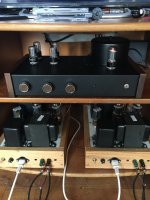Folks:
I'd appreciate some advice regarding hum and umbilical cables. My two-chassis Aikido preamplifier, which was built perhaps 15 years ago, has a small amount of hum. I've worked to reduce the noise and have had some success, but it isn't entirely gone. I suspect that the hum that remains is created in the 2.5' umbilical cable, where both AC and DC lines coexist. Is it likely that by rebuilding the umbilical cable and separating the AC and DC lines, each own its own braided copper sleeve, the hum would be eliminated or further reduced? I have lots of braided copper sleeve and could take this a step further -- the two B+ lines in one sleeve, heater in another, etc. -- if that might be a further improvement. All of the copper braids would be tied together and grounded, of course.
So, would twisted AC wires encased in braided copper sleeve running immediately next to DC wires encased in braided copper sleeve likely prevent the creation of hum in an umbilical cable, or will multiple braided copper sleeves bundled together have no effect on the hum?
Thanks in advance for your counsel!
Regards,
Scott
I'd appreciate some advice regarding hum and umbilical cables. My two-chassis Aikido preamplifier, which was built perhaps 15 years ago, has a small amount of hum. I've worked to reduce the noise and have had some success, but it isn't entirely gone. I suspect that the hum that remains is created in the 2.5' umbilical cable, where both AC and DC lines coexist. Is it likely that by rebuilding the umbilical cable and separating the AC and DC lines, each own its own braided copper sleeve, the hum would be eliminated or further reduced? I have lots of braided copper sleeve and could take this a step further -- the two B+ lines in one sleeve, heater in another, etc. -- if that might be a further improvement. All of the copper braids would be tied together and grounded, of course.
So, would twisted AC wires encased in braided copper sleeve running immediately next to DC wires encased in braided copper sleeve likely prevent the creation of hum in an umbilical cable, or will multiple braided copper sleeves bundled together have no effect on the hum?
Thanks in advance for your counsel!
Regards,
Scott
Attachments
-
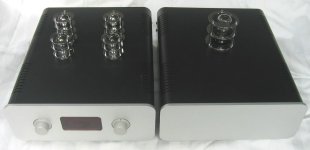 Aikido Preamp & PS (top view) 040807.jpg58.8 KB · Views: 193
Aikido Preamp & PS (top view) 040807.jpg58.8 KB · Views: 193 -
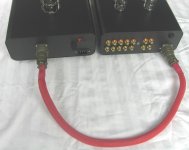 Aikido Preamp PS & Umbilical Cable 040807.jpg97.5 KB · Views: 200
Aikido Preamp PS & Umbilical Cable 040807.jpg97.5 KB · Views: 200 -
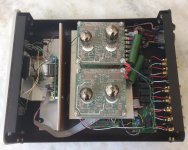 Aikido interior (full with tubes).JPG424.5 KB · Views: 199
Aikido interior (full with tubes).JPG424.5 KB · Views: 199 -
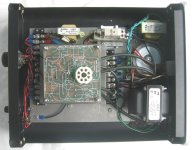 Aikido PS (exposed top view) 040807.jpg135.6 KB · Views: 193
Aikido PS (exposed top view) 040807.jpg135.6 KB · Views: 193 -
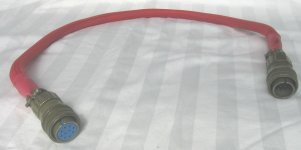 Aikido Umbilical Cable 040807.jpg52.9 KB · Views: 192
Aikido Umbilical Cable 040807.jpg52.9 KB · Views: 192
I suspect the hum was always there. The speakers changed a few years ago, which was when the hum became more apparent.
Regards.
Regards.
I had the same problem with a 12AX7 phono preamp I built with the power supply in a second chassis. I ended up having to use a CL-60 and diode bridge to isolate the IEC mains ground to audio ground. It's been silent ever since and the umbilical has the same A/C and D/C lines together, I did twist the A/C wires together and then twist the D/C wires together, not sure if it did anything.
elwood625:
Yup, I've added the humbuster (CL-60 and diode bridge assembly) as well, and it helped. But it didn't resolve the problem. I made several small improvements to the two chassis and most of those little changes did something, but the hum persists. I'm really wondering whether the hum is being created in the umbilical.
Regards.
Yup, I've added the humbuster (CL-60 and diode bridge assembly) as well, and it helped. But it didn't resolve the problem. I made several small improvements to the two chassis and most of those little changes did something, but the hum persists. I'm really wondering whether the hum is being created in the umbilical.
Regards.
Elwood's mod is more likely to work. Multiple routes to mains ground from audio ground in a chain of equipment can be troublesome, as well as power sharing audio ground wires and lack of care in star grounding. The usual stuff.
Do make sure the IEC/mains ground is still connected directly to the chassis/exposed metalwork. Safety first.
Do make sure the IEC/mains ground is still connected directly to the chassis/exposed metalwork. Safety first.
Since you have the parts, might as well try it.I have lots of braided copper sleeve and could take this a step further
I have read and always believed, when using a separate PS assembly, the final filter bypass capacitor should be in the amplifier chassis. And not further away at the leading end of the umbilical. Have you tried adding one, perhaps at the MS connector of the amp?
I have a Kevin Gilmore T2 high voltage tube amp for Stax electrostats. It is a dual chassis build and I am using one umbilical per channel (for total of two), where each include the AC lines for the heaters and DC lines for the amp itself mixed high and low voltage and there is absolutely no hum whatsoever. Make sure the AC lines are twisted. I doubt copper shielding will do anything - I don't have and amp is dead quiet.
Make sure you connect circuit ground to chassis only on one place and this is in the PSU case (best through a circuit breaker to PE). So, you would have two separate wires for circuit ground and chassis going from the PSU to the amp case. This is very important.
As your amp is single ended, make sure audio ground of the RCAs is not touching the chassis anywhere.
Disconnect all the RCA cables and check if you still have the hum?
Is this some sort of a display in front and have you any separation between analog and digital ground and how is this done?
Make sure you connect circuit ground to chassis only on one place and this is in the PSU case (best through a circuit breaker to PE). So, you would have two separate wires for circuit ground and chassis going from the PSU to the amp case. This is very important.
As your amp is single ended, make sure audio ground of the RCAs is not touching the chassis anywhere.
Disconnect all the RCA cables and check if you still have the hum?
Is this some sort of a display in front and have you any separation between analog and digital ground and how is this done?
Last edited:
I just built a home-brew, point-to-point octal Aikido and it was a challenge to get it quiet. I am using a toroid PT, diode rectifiers with a single 6AX4 to slow the warmup, a 47uF cap and a Neurochrome Maida regulator board for the B+. Filaments are simple DC supplies.
After a lot of experimentation, the key was to make sure that R8, R11, R15 and R16 are all perfectly in line with the recommendations in the manual, for the given tubes and supply voltages:
http://www.pcb-audio.com/pcb-audio_com/nine-pin_aikido_pcb.pdf
Otherwise the inherent noise cancellation will not be sufficient. My R16 turned out to be 98K instead of 100K. Fixing that solved most of the problem. A little tinkering with the ground scheme solved the rest.
Next I would recommend DC filaments if they are not already. There's plenty of room in that PS to add a small tranny, a bridge rectifier and a cap or two--or even a small reg'd 6V board you can buy on eBay. That's the end of any concern about the umbilical carrying AC and should also eliminate filament noise as a possibility. Make sure the DC filament supply is floated as it should be.
Finally, ground loops can be a problem, especially with PCBs. That looks like a fairly elaborate secondary-market kit, with relay sewitching and a remote control, is that right? Something like that. You'll need to trace the grounding scheme carefully and make sure there aren't any potential loops.
Hope this helps!
After a lot of experimentation, the key was to make sure that R8, R11, R15 and R16 are all perfectly in line with the recommendations in the manual, for the given tubes and supply voltages:
http://www.pcb-audio.com/pcb-audio_com/nine-pin_aikido_pcb.pdf
Otherwise the inherent noise cancellation will not be sufficient. My R16 turned out to be 98K instead of 100K. Fixing that solved most of the problem. A little tinkering with the ground scheme solved the rest.
Next I would recommend DC filaments if they are not already. There's plenty of room in that PS to add a small tranny, a bridge rectifier and a cap or two--or even a small reg'd 6V board you can buy on eBay. That's the end of any concern about the umbilical carrying AC and should also eliminate filament noise as a possibility. Make sure the DC filament supply is floated as it should be.
Finally, ground loops can be a problem, especially with PCBs. That looks like a fairly elaborate secondary-market kit, with relay sewitching and a remote control, is that right? Something like that. You'll need to trace the grounding scheme carefully and make sure there aren't any potential loops.
Hope this helps!
Attachments
Disconnect the input rca cables and see if there is a difference. Next short the input to ground to see if that does anything good. Often times the hum is coming from the source or cables. Also retighten the ground to chassis connection, they can loosen over time and then oxidize causing problems.
I have read and always believed, when using a separate PS assembly, the final filter bypass capacitor should be in the amplifier chassis. And not further away at the leading end of the umbilical. Have you tried adding one, perhaps at the MS connector of the amp?
Agreed. Filter at the source to prevent incoming noise, then again filter as close to the consuming component as possible.
I think the point about noise through ground loops is certainly a likely issue - you can check that by adding a 10mR resistor on the ground and then check the current flowing across it.
I know the aikido idea is to inject noise into the signal but inverted so it cancels out - however there must be a limit to the PSRR this provides.
Hi,I had the same problem with a 12AX7 phono preamp I built with the power supply in a second chassis. I ended up having to use a CL-60 and diode bridge to isolate the IEC mains ground to audio ground. It's been silent ever since and the umbilical has the same A/C and D/C lines together, I did twist the A/C wires together and then twist the D/C wires together, not sure if it did anything.
Sorry for my ignorance, but what is a cl-60?
I too also built a 12AX7 Phono preamp in a 2 box affair and I have had severe hum. I built it during the lockdown. I became despondent and I've ended up parking it. But now I'm looking to have another go.
This was my first attempt for about 25 years. I used to build all sorts of mashups and never had hum. I go and build something neat and I get Loads of hum.😂
Maybe I should start a separate thread. LOL
Cheers......Tony
An useful trick that solved the ground loop issue in my case is the input ground loop breaker:
Disconnect the point where the first tube (cathode, cathode resistor, whatever) goes to the signal ground. Insert a 10-12R resistor in between. The neutral of the input RCA shoul go to the top of the resistor, not directly to the signal ground.
Disconnect the point where the first tube (cathode, cathode resistor, whatever) goes to the signal ground. Insert a 10-12R resistor in between. The neutral of the input RCA shoul go to the top of the resistor, not directly to the signal ground.
On the input rca's , it looks like you have all the grounds directly connected to each other AND you have each ground going to the circuit board.
I doubt rebuilding the umbilical cord will do anything. Hum usually enters either via the B+ or the heaters. A regulated B+ and DC for the heaters solves that nicely. As others have pointed out, the wiring within the chassis makes a difference too.
Tom
Tom
Before you go ripping stuff apart it's worth checking that haven't got some valves with leaky heater-cathode insulation. Try a valve swap or two to see if anything changes. After that, hum loops are the most likely issue.
rif:On the input rca's , it looks like you have all the grounds directly connected to each other AND you have each ground going to the circuit board.
Nope. The grounds on all of the inputs are tied together and are connected to the Dantimax input board through a 10 ohm resistor.
mdpaudio:
The hum is unaffected when the input RCA interconnects are all removed.
grovergardner & Tom:
Thank you! I'll try that first, before rebuilding the umbilical.
Regards.
- Home
- Amplifiers
- Tubes / Valves
- An Umbilical Question
